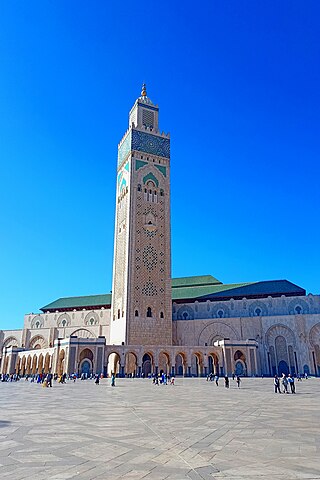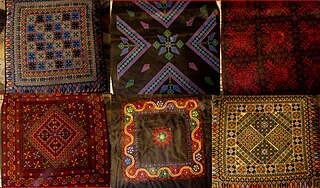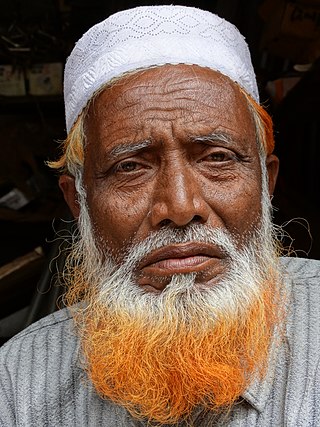Related Research Articles
Black is a racialized classification of people, usually a political and skin color-based category for specific populations with a mid- to dark brown complexion. Not all people considered "black" have dark skin; in certain countries, often in socially based systems of racial classification in the Western world, the term "black" is used to describe persons who are perceived as dark-skinned compared to other populations. It is most commonly used for people of sub-Saharan African ancestry, Indigenous Australians and Melanesians, though it has been applied in many contexts to other groups, and is no indicator of any close ancestral relationship whatsoever. Indigenous African societies do not use the term black as a racial identity outside of influences brought by Western cultures.

Moroccan cuisine is the cuisine of Morocco, fueled by interactions and exchanges with many cultures and nations over the centuries. Moroccan cuisine is usually a mix of Arab, Berber, Andalusi, and Mediterranean cuisines, with minimal European and sub-Saharan influences. Like the rest of the Maghrebi cuisine, Moroccan cuisine has more in common with Middle Eastern cuisine than with the rest of Africa.

Soap is a salt of a fatty acid used in a variety of cleansing and lubricating products. In a domestic setting, soaps are surfactants usually used for washing, bathing, and other types of housekeeping. In industrial settings, soaps are used as thickeners, components of some lubricants, and precursors to catalysts.

A hammam or Turkish bath is a type of steam bath or a place of public bathing associated with the Islamic world. It is a prominent feature in the culture of the Muslim world and was inherited from the model of the Roman thermae. Muslim bathhouses or hammams were historically found across the Middle East, North Africa, al-Andalus, Central Asia, the Indian subcontinent, and in Southeastern Europe under Ottoman rule. A variation on the Muslim bathhouse, Victorian Turkish baths, became popular as a form of therapy, a method of cleansing, and a place for relaxation during the Victorian era, rapidly spreading through the British Empire, the United States, and Western Europe.

The Hassan II Mosque is a mosque in Casablanca, Morocco. It is the second largest functioning mosque in Africa and is the 14th largest in the world. Its minaret is the world's second tallest minaret at 210 metres (689 ft). Completed in 1993, it was designed by Michel Pinseau under the guidance of King Hassan II and built by Moroccan artisans from all over the kingdom. The minaret is 60 stories high topped by a laser, the light from which is directed towards Mecca. The mosque stands on a promontory looking out to the Atlantic Ocean; worshippers can pray over the sea but there is no glass floor looking into the sea. The walls are of hand-crafted marble and the roof is retractable. A maximum of 105,000 worshippers can gather together for prayer: 25,000 inside the mosque hall and another 80,000 on the mosque's outside ground.

Shea butter is a fat extracted from the nut of the African shea tree. It is ivory in color when raw and commonly dyed yellow with borututu root or palm oil. It is widely used in cosmetics as a moisturizer, salve or lotion. It is edible and is used in food preparation in some African countries. It is occasionally mixed with other oils as a substitute for cocoa butter, although the taste is noticeably different.

Tadelakt is a waterproof plaster surface used in Moroccan architecture to make baths, sinks, water vessels, interior and exterior walls, ceilings, roofs, and floors. It is made from lime plaster, which is rammed, polished, and treated with soap to make it waterproof and water-repellent. Tadelakt is labour-intensive to install, but durable. Since it is applied as a paste, tadelakt has a soft, undulating character, it can form curves, and it is seamless. Pigment can be added to give it any colour, but deep red is traditional. It may have a shiny or matte finish.

Abu Al-Hasan 'Ali ibn 'Othman, was a sultan of the Marinid dynasty who reigned in Morocco between 1331 and 1348. In 1333 he captured Gibraltar from the Castilians, although a later attempt to take Tarifa in 1339 ended in fiasco. In North Africa he extended his rule over Tlemcen and Hafsid Ifriqiya, which together covered the north of what is now Algeria and Tunisia. Under him the Marinid realms in the Maghreb briefly covered an area that rivalled that of the preceding Almohad Caliphate. However, he was forced to retreat due to a revolt of the Arab tribes, was shipwrecked, and lost many of his supporters. His son Abu Inan Faris seized power in Fez. Abu Al-Hasan died in exile in the High Atlas mountains.
Identifying human races in terms of skin colour, at least as one among several physiological characteristics, has been common since antiquity. Such divisions appeared in rabbinical literature and in early modern scholarship, usually dividing humankind into four or five categories, with colour-based labels: red, yellow, black, white, and sometimes brown. It was long recognized that the number of categories is arbitrary and subjective, and different ethnic groups were placed in different categories at different points in time. François Bernier (1684) doubted the validity of using skin color as a racial characteristic, and Charles Darwin (1871) emphasized the gradual differences between categories. Today there is broad agreement among scientists that typological conceptions of race have no scientific basis.

Marseille soap or Savon de Marseille is a traditional hard soap made from vegetable oils that has been produced around Marseille, France, for about 600 years. The first documented soapmaker was recorded from the city in about 1370. By 1688, Louis XIV introduced regulations in the Edict of Colbert limiting the use of the name Savon de Marseille to olive oil based soaps. The law has since been amended to allow other vegetable oils to be used.

Algeria is the largest country in Africa; one of the main tourist attractions is the Sahara, the largest desert in the world. Algeria has been a member of the World Tourism Organization since 1976. According to a report of the World Tourism Organization published in 2014, Algeria was the 4th largest tourist destination in Africa in 2013 with 2.7 million foreign tourists, and ranks 111th on the international tourism scene, according to the London-based World Tourism and Travel Council (WTTC). The tourism sector in Algeria accounts for 3.9% of the volume of exports, 9.5% of the productive investment rate and 8.1% of the gross domestic product.

Palestinian handicrafts are handicrafts produced by Palestinian people. A wide variety of handicrafts, many of which have been produced by Arabs in Palestine for hundreds of years, continue to be produced today. Palestinian handicrafts include embroidery work, pottery-making, soap-making, glass-making, weaving, and olive-wood and Mother of Pearl carvings, among others. Some Palestinian cities in the West Bank, particularly Bethlehem, Hebron and Nablus have gained renown for specializing in the production of a particular handicraft, with the sale and export of such items forming a key part of each cities' economy.

Aleppo soap is a handmade, hard bar soap associated with the city of Aleppo, Syria. Aleppo soap is classified as a Castile soap as it is a hard soap made from olive oil and lye, from which it is distinguished by the inclusion of laurel oil.

Henna is a black dye prepared from the dried and powdered leaves of the henna tree. It has been used since at least the ancient Egyptian period as a hair and body dye, notably the temporary body art of mehndi resulting from the staining of the skin using dyes from the henna plant. After henna stains reach their peak colour, they hold for a few days, then gradually wear off by way of exfoliation, typically within one to three weeks.

Nabulsi soap is a type of castile soap produced in Nablus in the West Bank, Palestine. Its chief ingredients are virgin olive oil, water, and an alkaline sodium compound, such as sodium hydroxide. The finished product is ivory-colored and has almost no scent. Traditionally made by women for household use, it had become a significant industry for Nablus by the 14th century. In 1907 the city's 30 Nabulsi soap factories were supplying half the soap in Palestine. The industry declined during the mid-20th century following the destruction caused by the 1927 Jericho earthquake and later disruption from the Israeli military occupation. As of 2008, only two soap factories survive in Nablus. The old Arafat soap factory has been turned into a Cultural Heritage Enrichment Center.
Palmolive is an American multinational brand of a line of products produced by Colgate-Palmolive. The Palmolive brand grew from one product, Palmolive bar soap. Made of coconut, palm and olive oils, Palmolive bar soap was introduced in 1898. Originally, the bar soap floated like Procter & Gamble's Ivory bar soap. By the turn of the 20th century, Palmolive bar soap was the world's best-selling soap.

Imaan Hammam is a Dutch fashion model. As of 2024, she has appeared on the cover of Vogue 22 times, four times on the American edition. She currently ranks on models.com's "Industry Icons" and was ranked on its "Top Sexiest Models" lists. As of 2021, she has appeared on The Big Four covers of Vogue. Hammam is one of the most in demand and one of the most highest paid models of her generation and currently ranks under ''Money'' and ''Supers'' on models.com.

The Hammam as-Saffarin is a historic hammam (bathhouse) in the medina of Fes, Morocco. It is located on the southwest side of Place Seffarine, across from the Madrasa Saffarin and south of the Qarawiyyin Mosque.
Hammam al-Mokhfiya is a historic hammam (bathhouse) in the medina of Fes, Morocco. It is located in the neighbourhood of the same name (al-Mokhfiya), south of Place R'cif. Based on its similarities in layout and decoration with other historic hammams in the region, it has been dated to the mid-14th century, during the reign of the Marinid sultan Abu Inan or slightly after. The hammam is richly decorated with carved stucco and carved wood in its changing room, as well as zellij tiling in its steam rooms. The hammam was part of the habous (endowment) of the Qarawiyyin Mosque.
Hammam Ben Abbad or Hammam Ibn Abbad is a historic hammam (bathhouse) in the medina of Fes, Morocco. It is located in the Kettanin neighbourhood south of the Zawiya of Moulay Idris, near the Funduq Kettanin. The hammam dates from the 14th century and was recently restored during a major rehabilitation program involving over two dozen other historic monuments in the city. Its name comes from a local Muslim saint who is associated with the building, and the waters of the hammam were believed to have healing properties. Entered from the north, the hammam has the usual series of rooms inherited from the Roman bathhouse model: an undressing room, a cold room (frigidarium), warm room (tepidarium), and a hot room (calderium). The hammam was part of the habous (endowment) of the Qarawiyyin Mosque.
References
- 1 2 "The Benefits of Castile Soap, particularly Moroccan Black Soap" . Retrieved August 4, 2018.
- ↑ "How to Experience a Hammam in Marrakech Like a Local" . Retrieved August 4, 2018.
- ↑ "The Naked Truth About Moroccan Baths" . Retrieved August 4, 2018.